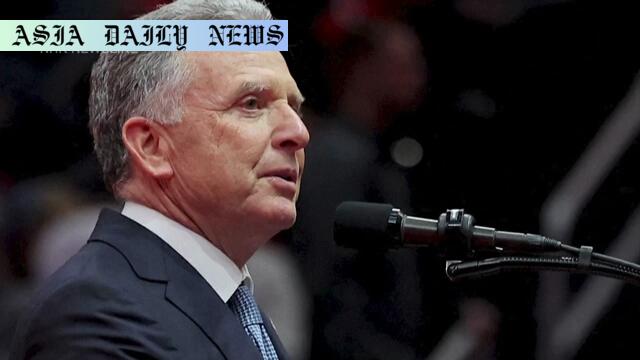Gaza famine, Witkoff inspects food distribution, seeks to address pressing issues of food insecurity and humanitarian crisis.

US Envoy’s Visit Sheds Light on Gaza’s Food Crisis
The Gaza Strip, a region persistently under scrutiny for its humanitarian struggles, has recently seen heightened attention due to a severe famine crisis. On Friday, US special envoy Steve Witkoff visited a food distribution center in Gaza, highlighting severe food shortages affecting the region. According to Israeli media reports, the visit was intended to provide the envoy with a closer look at the ongoing food insecurity issue, a problem that has escalated into what some experts are calling a ‘worst-case scenario of famine.’
The White House has affirmed that Witkoff’s presence in Gaza was central to a mission of understanding the scale of food supply issues. His objective focused on inspecting aid distribution mechanisms and listening to the lived experiences of the local population. The United Nations, which has long been involved in humanitarian operations in Gaza, corroborated the reports of escalating food insecurity, noting that the situation has reached the lowest point on their food security scale. According to their analysis, many residents, including children, are on the edge of starvation, raising moral and geopolitical questions about the roles and responsibilities of involved stakeholders. Meanwhile, US President Donald Trump publicly acknowledged the severity of the crisis, labeling it a tragedy for Gaza’s youth.
Mixed Reactions and Political Implications of the Visit
Although Witkoff’s visit was largely seen as a proactive step toward evaluating aid efficacy, it has not been without its critics. Hamas, the political and militant power in Gaza, dismissed the envoy’s trip as a superficial attempt to deflect blame onto other actors. In a strongly worded social media post, Hamas framed Witkoff’s mission as propaganda designed to mitigate anger directed at the US and Israel, both of which they accuse of facilitating Gaza’s economic siege. Despite their criticism, Hamas signaled a willingness to engage in ceasefire negotiations contingent on the resolution of the ongoing famine.
Geopolitical analysts have weighed in on the significance of this visit, suggesting that it could act as a catalyst for renewed discussions on the decades-long conflict in the region. They point out that the humanitarian lens Witkoff employed could help redirect focus toward more immediate and basic needs in the region, potentially setting the stage for broader peace talks. However, critics fear that without sustained commitment from international powers, such visits may simply gloss over the structural issues underlying Gaza’s plight.
Urgent Need for Long-term Humanitarian Solutions
The worsening conditions in Gaza underscore the pressing need for robust and sustained humanitarian interventions. The severe state of food insecurity, as highlighted by the United Nations, is just one aspect of a multi-faceted crisis that includes unemployment, a failing healthcare system, and limited access to basic utilities. Experts continue to advocate for long-term solutions that go beyond temporary aid distributions. They emphasize the need for political dialogue and economic initiatives to enable Gaza’s residents to become self-sufficient and escape the persistent cycle of poverty and dependency.
Observers note that Witkoff’s visit could serve as a stepping stone for garnering greater international attention and action. However, the continuation of blockades, lack of political stability, and enduring distrust between factions remain significant obstacles. Thus, while immediate food aid may alleviate certain critical needs, comprehensive strategies involving all stakeholders—local, regional, and international—are essential to securing sustainable futures for Gaza’s population.
Commentary
The Importance of Global Attention on Gaza’s Crisis
The recent visit by US envoy Steve Witkoff to the Gaza Strip underscores the critical role of international attention in addressing longstanding humanitarian crises. While many conflict zones worldwide struggle to capture sustained global focus, Gaza’s plight reflects a particularly dire intersection of political instability and human suffering. The presence of a high-profile figure like Witkoff not only galvanizes attention but also brings a sense of urgency to the ongoing famine crisis that has gripped the enclave. Beyond diplomacy, such visits amplify the voices of those often sidelined in large geopolitical discussions—the ordinary citizens enduring unimaginable hardships.
The Role of Stakeholders in Building Lasting Change
Hamas’ criticisms of the visit as “propaganda” bring to light central debates about responsibility and effectiveness in orchestrating humanitarian interventions. Should accountability rest with Gaza’s political administrators, its influential neighbors, or the far-reaching global powers that often dictate terms of aid distribution? The answer isn’t as straightforward as assigning blame; rather, progress depends on cooperation among all parties to set aside conflicts and prioritize the welfare of vulnerable populations. For example, ceasefire negotiations contingent on famine alleviation could serve as stepping stones toward greater compromises, provided there’s a genuine commitment to resolve the foundational issues afflicting Gaza’s economy and infrastructure.
Hope Amid the Crisis
Despite the complexity of Gaza’s challenges, Witkoff’s mission serves as a reminder that meaningful action remains possible with the right combination of attention, funding, and leadership. Although large-scale crises like this often seem insurmountable, even incremental improvements can save lives and restore dignity to communities in need. If Witkoff’s visit sparks wider global acknowledgment and collaboration, it could mark the beginning of a turning point for this beleaguered region. However, sustained effort and political will are ultimately necessary to translate short-term relief into long-lasting change for the people of Gaza.


